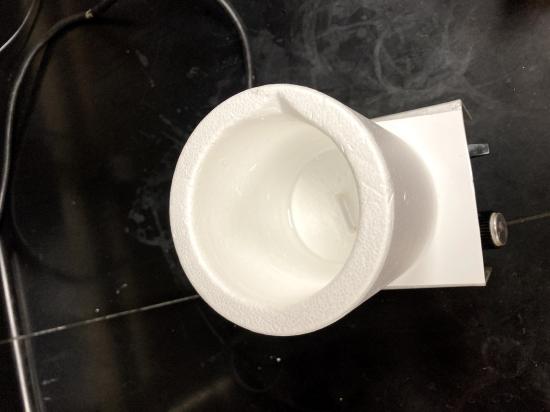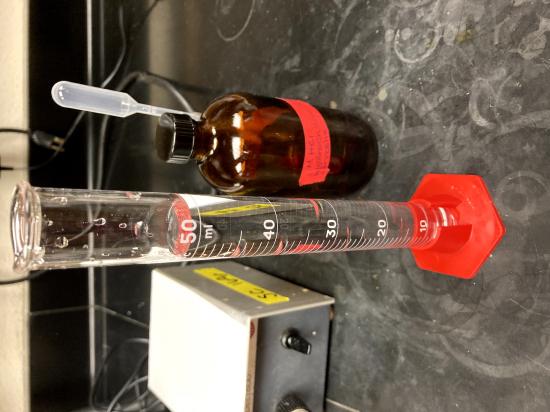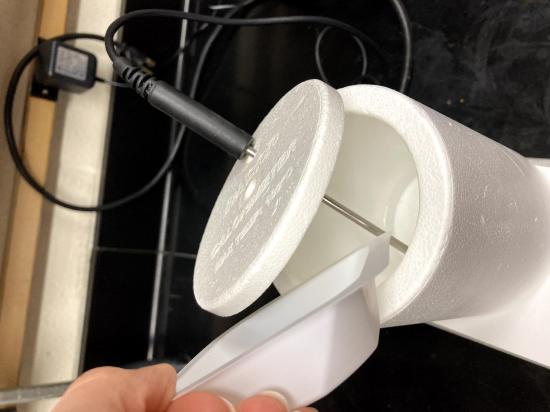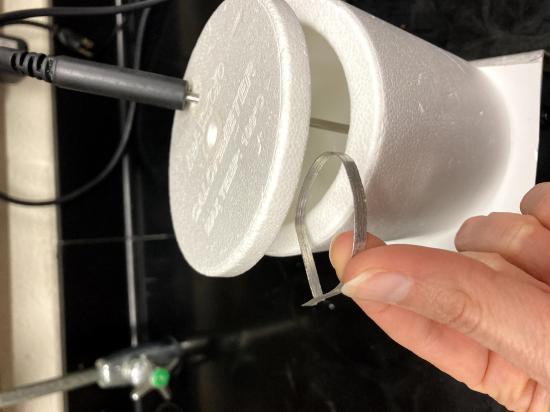8: Hess's Law
- Page ID
- 316203
\( \newcommand{\vecs}[1]{\overset { \scriptstyle \rightharpoonup} {\mathbf{#1}} } \)
\( \newcommand{\vecd}[1]{\overset{-\!-\!\rightharpoonup}{\vphantom{a}\smash {#1}}} \)
\( \newcommand{\dsum}{\displaystyle\sum\limits} \)
\( \newcommand{\dint}{\displaystyle\int\limits} \)
\( \newcommand{\dlim}{\displaystyle\lim\limits} \)
\( \newcommand{\id}{\mathrm{id}}\) \( \newcommand{\Span}{\mathrm{span}}\)
( \newcommand{\kernel}{\mathrm{null}\,}\) \( \newcommand{\range}{\mathrm{range}\,}\)
\( \newcommand{\RealPart}{\mathrm{Re}}\) \( \newcommand{\ImaginaryPart}{\mathrm{Im}}\)
\( \newcommand{\Argument}{\mathrm{Arg}}\) \( \newcommand{\norm}[1]{\| #1 \|}\)
\( \newcommand{\inner}[2]{\langle #1, #2 \rangle}\)
\( \newcommand{\Span}{\mathrm{span}}\)
\( \newcommand{\id}{\mathrm{id}}\)
\( \newcommand{\Span}{\mathrm{span}}\)
\( \newcommand{\kernel}{\mathrm{null}\,}\)
\( \newcommand{\range}{\mathrm{range}\,}\)
\( \newcommand{\RealPart}{\mathrm{Re}}\)
\( \newcommand{\ImaginaryPart}{\mathrm{Im}}\)
\( \newcommand{\Argument}{\mathrm{Arg}}\)
\( \newcommand{\norm}[1]{\| #1 \|}\)
\( \newcommand{\inner}[2]{\langle #1, #2 \rangle}\)
\( \newcommand{\Span}{\mathrm{span}}\) \( \newcommand{\AA}{\unicode[.8,0]{x212B}}\)
\( \newcommand{\vectorA}[1]{\vec{#1}} % arrow\)
\( \newcommand{\vectorAt}[1]{\vec{\text{#1}}} % arrow\)
\( \newcommand{\vectorB}[1]{\overset { \scriptstyle \rightharpoonup} {\mathbf{#1}} } \)
\( \newcommand{\vectorC}[1]{\textbf{#1}} \)
\( \newcommand{\vectorD}[1]{\overrightarrow{#1}} \)
\( \newcommand{\vectorDt}[1]{\overrightarrow{\text{#1}}} \)
\( \newcommand{\vectE}[1]{\overset{-\!-\!\rightharpoonup}{\vphantom{a}\smash{\mathbf {#1}}}} \)
\( \newcommand{\vecs}[1]{\overset { \scriptstyle \rightharpoonup} {\mathbf{#1}} } \)
\( \newcommand{\vecd}[1]{\overset{-\!-\!\rightharpoonup}{\vphantom{a}\smash {#1}}} \)
\(\newcommand{\avec}{\mathbf a}\) \(\newcommand{\bvec}{\mathbf b}\) \(\newcommand{\cvec}{\mathbf c}\) \(\newcommand{\dvec}{\mathbf d}\) \(\newcommand{\dtil}{\widetilde{\mathbf d}}\) \(\newcommand{\evec}{\mathbf e}\) \(\newcommand{\fvec}{\mathbf f}\) \(\newcommand{\nvec}{\mathbf n}\) \(\newcommand{\pvec}{\mathbf p}\) \(\newcommand{\qvec}{\mathbf q}\) \(\newcommand{\svec}{\mathbf s}\) \(\newcommand{\tvec}{\mathbf t}\) \(\newcommand{\uvec}{\mathbf u}\) \(\newcommand{\vvec}{\mathbf v}\) \(\newcommand{\wvec}{\mathbf w}\) \(\newcommand{\xvec}{\mathbf x}\) \(\newcommand{\yvec}{\mathbf y}\) \(\newcommand{\zvec}{\mathbf z}\) \(\newcommand{\rvec}{\mathbf r}\) \(\newcommand{\mvec}{\mathbf m}\) \(\newcommand{\zerovec}{\mathbf 0}\) \(\newcommand{\onevec}{\mathbf 1}\) \(\newcommand{\real}{\mathbb R}\) \(\newcommand{\twovec}[2]{\left[\begin{array}{r}#1 \\ #2 \end{array}\right]}\) \(\newcommand{\ctwovec}[2]{\left[\begin{array}{c}#1 \\ #2 \end{array}\right]}\) \(\newcommand{\threevec}[3]{\left[\begin{array}{r}#1 \\ #2 \\ #3 \end{array}\right]}\) \(\newcommand{\cthreevec}[3]{\left[\begin{array}{c}#1 \\ #2 \\ #3 \end{array}\right]}\) \(\newcommand{\fourvec}[4]{\left[\begin{array}{r}#1 \\ #2 \\ #3 \\ #4 \end{array}\right]}\) \(\newcommand{\cfourvec}[4]{\left[\begin{array}{c}#1 \\ #2 \\ #3 \\ #4 \end{array}\right]}\) \(\newcommand{\fivevec}[5]{\left[\begin{array}{r}#1 \\ #2 \\ #3 \\ #4 \\ #5 \\ \end{array}\right]}\) \(\newcommand{\cfivevec}[5]{\left[\begin{array}{c}#1 \\ #2 \\ #3 \\ #4 \\ #5 \\ \end{array}\right]}\) \(\newcommand{\mattwo}[4]{\left[\begin{array}{rr}#1 \amp #2 \\ #3 \amp #4 \\ \end{array}\right]}\) \(\newcommand{\laspan}[1]{\text{Span}\{#1\}}\) \(\newcommand{\bcal}{\cal B}\) \(\newcommand{\ccal}{\cal C}\) \(\newcommand{\scal}{\cal S}\) \(\newcommand{\wcal}{\cal W}\) \(\newcommand{\ecal}{\cal E}\) \(\newcommand{\coords}[2]{\left\{#1\right\}_{#2}}\) \(\newcommand{\gray}[1]{\color{gray}{#1}}\) \(\newcommand{\lgray}[1]{\color{lightgray}{#1}}\) \(\newcommand{\rank}{\operatorname{rank}}\) \(\newcommand{\row}{\text{Row}}\) \(\newcommand{\col}{\text{Col}}\) \(\renewcommand{\row}{\text{Row}}\) \(\newcommand{\nul}{\text{Nul}}\) \(\newcommand{\var}{\text{Var}}\) \(\newcommand{\corr}{\text{corr}}\) \(\newcommand{\len}[1]{\left|#1\right|}\) \(\newcommand{\bbar}{\overline{\bvec}}\) \(\newcommand{\bhat}{\widehat{\bvec}}\) \(\newcommand{\bperp}{\bvec^\perp}\) \(\newcommand{\xhat}{\widehat{\xvec}}\) \(\newcommand{\vhat}{\widehat{\vvec}}\) \(\newcommand{\uhat}{\widehat{\uvec}}\) \(\newcommand{\what}{\widehat{\wvec}}\) \(\newcommand{\Sighat}{\widehat{\Sigma}}\) \(\newcommand{\lt}{<}\) \(\newcommand{\gt}{>}\) \(\newcommand{\amp}{&}\) \(\definecolor{fillinmathshade}{gray}{0.9}\)Learning Objectives
- To determine the enthalpy, \(\Delta H\), of several reactions experimentally.
- To use Hess's Law to determine the enthalpy, \(\Delta H\), for a reaction
The study of energy is a vital function of chemistry. Over 90 percent of the energy we produce comes from chemical reactions such as the combustion of fossil fuels. This study of energy and its transformations is known as thermochemistry. As chemical bonds break and form in a chemical reaction, energy in the form of heat is either released or absorbed. Under conditions of constant pressure, the energy change of a reaction is called the heat of reaction or enthalpy change, \(\Delta H\). The amount of heat either absorbed or released during a reaction can be measured if the reaction is carried out in a container that insulates the reaction from its surroundings. By convention if heat is released, the reaction is termed exothermic and \(\Delta H\) is negative. If heat is absorbed, the reaction is termed endothermic and \(\Delta H\) is positive. In this lab, you will determine experimentally the value for \(\Delta H\) for the acid-base neutralization reaction involving hydrochloric acid and sodium hydroxide.
Exothermic: \(\Delta H\) < 0 Endothermic: \(\Delta H\) > 0
We have defined the reactants as part of the system. The solvent (water in this case) and the calorimeter itself are the surroundings. By measuring the heat absorbed by the solvent and the calorimeter, we can infer the heat change for the reaction. This assumes, of course, that there is no heat loss. Using an apparatus called a calorimeter, the heat lost or absorbed by a reaction in the calorimeter can be calculated using the following equation:
\(\Delta H\) reaction = \(\Delta H\) calorimeter + \(\Delta H\) solution
For our purposes, we will assume that the heat gained or lost by the calorimeter itself is negligible. Thus, we will simply use the heat lost or gained by the solution.
The enthalpy change, \(\Delta H\), is determined by measuring the temperature change, \(\Delta T\), and the mass of the system. The product of the mass, the specific heat and temperature change of the system will give the enthalpy change for the system. The heat capacity of 1 g of a substance is called its specific heat capacity (4.18 J/g°C for water).
\(\Delta H\) = (specific heat of water) x (grams of solution) x (\(\Delta T\))
In this experiment we will measure the heat of neutralization of the following reaction:
\[\ce{H^{+} (aq)} + \ce{OH^{-} (aq)} \rightarrow \ce{H_{2}^O} (l) \label{1}\]
In addition we will measure the heats of reactions 2 and 3, shown below. Knowing the heat of reaction for 4, we will use Hess’s Law and reaction 2-4 to calculate the heat of reaction for 5.
\[\ce{MgO (s)} + 2\space\ce{HCl (aq)} \rightarrow \ce{Mg^{2+} (aq)} + 2\space\ce{Cl^{-} (aq)} + \ce{H_{2}O (l)} \label{2}\]
\[\ce{Mg (s)} + 2\space\ce{HCl (aq)} \rightarrow \ce{Mg^{2+} (aq)} + 2\space\ce{Cl^{-} (aq)} + \ce{H_{2} (g)} \label{3}\]
\[\ce{H_{2} (g)} + \frac{1}{2}\space \ce{O_{2} (g)} \rightarrow \ce{H_{2}^O (l)} \label{4}\]
\[\ce{Mg (s)} + \frac {1}{2}\space\ce{O_{2} (g)} \rightarrow 2\space\ce{MgO (s)} \label{5}\]
Pre Lab Video
Safety and Waste Disposal
- All solutions can be disposed of down the drain.
Procedure
Heat of Neutralization: \(\ce{H^{+} (aq)} + \ce{OH^{-} (aq)} \rightarrow \ce{H_{2}^O} (l) \)
Step 1
Obtain a calorimeter consisting of a double Styrofoam cup, a magnetic stirrer and magnet, and the LabQuest with the temperature sensor.
Step 2
 Pour 25.0 mL of 2M sodium hydroxide (NaOH), measured with your graduated cylinder, into your calorimeter.
Pour 25.0 mL of 2M sodium hydroxide (NaOH), measured with your graduated cylinder, into your calorimeter.
Step 3
 Measure 25.0 mL of 2M hydrochloric acid (HCl) in clean, graduated cylinder. Clean and dry the
Measure 25.0 mL of 2M hydrochloric acid (HCl) in clean, graduated cylinder. Clean and dry the  temperature sensor and support it in the NaOH solution.
temperature sensor and support it in the NaOH solution.
Step 4
 Begin gently stirring the solution with the magnetic stirrer.
Begin gently stirring the solution with the magnetic stirrer.
Step 5
Tap the “Start” button. Allow several data points to be collected for 15 seconds to set the initial temperature.
Step 6
 With the run ongoing, add the acid (HCl) solution to the base (NaOH),
With the run ongoing, add the acid (HCl) solution to the base (NaOH),
Step 7
When the temperature starts to decline, tap the “stop” button. Click the “analyze” menu and then selecting “Statistics”, “Temperature” to record the maximum temperature reached and the initial temperature.
Step 8
Empty your calorimeter (the materials can go down the drain), rinse, and dry all parts completely.
Step 9
Repeat the procedure at least once more. If your data looks substantially different between the two runs, repeat a third time. Accurate results will be rewarded.
Reaction #2: \(\ce{MgO (s)} + 2\space\ce{HCl (aq)} \rightarrow \ce{Mg^{2+} (aq)} + 2\space\ce{Cl^{-} (aq)} + \ce{H_{2}O (l)}\)
Step 1
 Measure out 50.0 mL of 1M HCl into the calorimeter. CAUTION: This is a different HCl concentration than the one used in Reaction #1. Handle the HCl solution with care. It can cause painful burns if it comes in contact with the skin.
Measure out 50.0 mL of 1M HCl into the calorimeter. CAUTION: This is a different HCl concentration than the one used in Reaction #1. Handle the HCl solution with care. It can cause painful burns if it comes in contact with the skin.
Step 2
 Weigh out about 0.50 g of magnesium oxide, MgO, on a piece of weighing paper. Record the exact mass used in your data table. CAUTION: Avoid inhaling magnesium oxide dust.
Weigh out about 0.50 g of magnesium oxide, MgO, on a piece of weighing paper. Record the exact mass used in your data table. CAUTION: Avoid inhaling magnesium oxide dust.
Step 3
 Tap the start button and record the temperature for 15 seconds. Then add the white magnesium oxide powder to the solution. Use the magnetic stirrer to gently to stir the cup contents until a maximum temperature has been reached. Record the minimum and maximum temperatures. The waste can go down the drain.
Tap the start button and record the temperature for 15 seconds. Then add the white magnesium oxide powder to the solution. Use the magnetic stirrer to gently to stir the cup contents until a maximum temperature has been reached. Record the minimum and maximum temperatures. The waste can go down the drain.
Step 4
Repeat the procedure once more.
Step 5
Clean and dry the calorimeter cup, the stir bar, and the thermometer.
Reaction #3: \(\ce{Mg (s)} + 2\space\ce{HCl (aq)} \rightarrow \ce{Mg^{2+} (aq)} + 2\space\ce{Cl^{-} (aq)} + \ce{H_{2} (g)}\)
Step 1
 Repeat the above experiment using ~0.2 g of Mg. ribbon rather than the
Repeat the above experiment using ~0.2 g of Mg. ribbon rather than the  MgO powder. The magnesium ribbon has been pre-cut to the proper length. Be sure to record the measured mass of the magnesium and the initial and final temperatures. CAUTION: Do not breathe the vapors produced by this reaction! The waste can go down the drain.
MgO powder. The magnesium ribbon has been pre-cut to the proper length. Be sure to record the measured mass of the magnesium and the initial and final temperatures. CAUTION: Do not breathe the vapors produced by this reaction! The waste can go down the drain.
Processing the Data
All calculations should be neatly presented in your laboratory notebook.
Step 1
For each reaction the heat gained or lost by the solution is found using: \(q_{soln}\) = \(C_{p}•m•\Delta T\). [Cp = \(4.18\frac {J}{g^{o}C}\) and we assume that the solution has the same density as water,\(1\frac {g}{mL}\)]
Step 2
Calculate the heat gained or lost by the reaction, \(q_{rnx}\) = \(-q_{soln}\)
Step 3
Calculate \(\Delta H_{rxn}\) for each reaction. \(\Delta H_{rxn}\) = \(\frac {q_{rxn}}{moles}\).
Step 4
Using Hess's law and your experimental \(\Delta H_{rxn}\) values for reactions 2 and 3, and the calculated value from the table in the back of the book for reaction 4 (\(\ce{H_{2} (g)} + \frac{1}{2}\space \ce{O_{2} (g)} \rightarrow \ce{H_{2}^O (l)}\)), to calculate the \(\Delta H_{rxn}\) for reaction 5.

